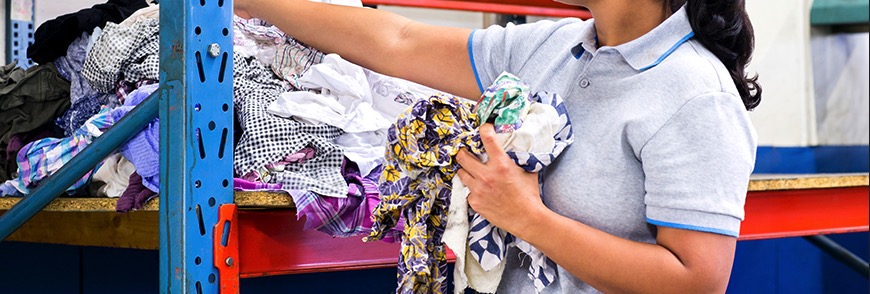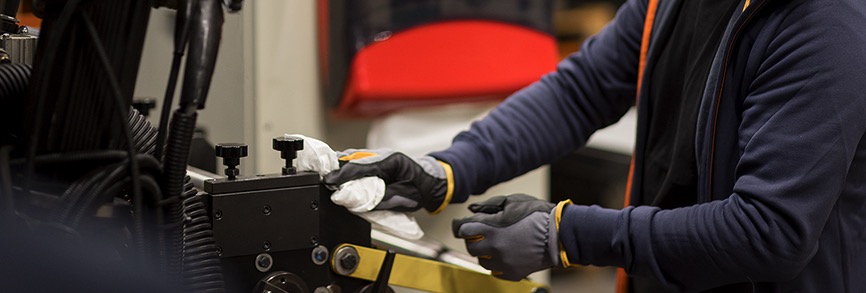Many industrial facilities still use rags made from textiles for wiping and cleaning tasks, but rags are less optimal than cleaning cloths. Cleaning cloths and rags are not interchangeable. Their design and characteristics make them very different—especially when it comes to efficiency and savings in time, money, and effort. The disadvantages of rags may not be obvious in the middle of mopping up an oily spill but understanding the full advantages of cleaning cloths that are manufactured specifically for that purpose could benefit your bottom line.
An overview of rags
Industrial customers have historically used rags because they’re cheap, disposable, durable, and “recycled” from their original use. However, you never know exactly what you’re going to get with rags because they come from a variety of sources. These include used clothes and towels, leftovers from the textile industry, and old bedding from hospitals or commercial laundries. The many different materials—from thick flannel to thin cotton—are then cut into a range of sizes. Rags go through a detector so items like buttons and zippers can be removed, but plastic fixings can be overlooked. The rags are then vacuum sealed as large, unwieldy bales.
Common rag types and qualities include the following:
- White cleaning cloths: Made from laundry grade recycled sheeting, they are washed and sterilized
- T-shirt cloths: Colored, medium weight cotton t-shirts recycled as rags
- Flannel wyncette: Made from material softer than cotton t-shirts
- Terry toweling: Made from ex-commercial laundry, bathrobes, and towels

The perceived benefits of rags
Initially, rags sound like a great option. They’re typically cheap yet relatively strong. Cotton rags are often low lint. Users also appreciate the large sizes, providing protection to hands from potentially hazardous or abrasive substances during cleanups.
The realities of rags can be problematic
Rags come with significant drawbacks that customers may not entirely understand initially. Because the various rag materials were never intended for cleaning use, their efficacy can vary significantly from one material to the next. The quality can vary greatly within each bale as there can be a combination of thick, thin, new, or frayed materials. The increasing use of synthetics also makes some rags less absorbent so a large number may need to be used for some wiping and cleaning tasks.
On the shop floor, the bales of rags can be cumbersome to store. Yet some individual rags may end up being too small to be used. Employees often waste time searching through a disorganized pile to find a preferred type of material or size. Messy, bulky bins for new and used rags create clutter and chaos—a significant trip hazard in busy warehouses and factories. They also create a lot of waste that must be collected and discarded.
Rags may seem cheaper than cleaning cloths based on initial purchase price. However, many other factors make cleaning cloths a better choice when all cleaning costs—including time, money, and increased volumes of solvents—are considered.

The advantages of Tork cleaning cloths over rags
Cleaning cloths designed for industrial use offer a range of benefits compared to rags. These can result in significant improvements in industrial environments.
- Effectiveness: While rags come from clothing or bedding fabrics, Tork cloths are designed for maximum strength and absorbency in cleaning. Their consistent size and quality mean they also offer the same performance every time.
- Convenience: As the saying goes, time is money. Cloths can be stored in accessible dispensers throughout the shop floor. This makes them easier and faster to retrieve and start using compared to the typical search through a jumble of rags in a large, centralized pile or a bin.
- Increased productivity and cost savings: Many factors contribute to total cost savings of using cleaning cloths on the shop floor. Most important, faster cleaning times reduce downtime and ensure facilities and equipment are ready for production. Because Tork cloths absorb solvent more quickly than rags and release it more evenly, they require less of it for cleaning and wiping tasks. Plus, cloths weigh less than rags, leading to lower waste removal costs.
- Less effort: Rags often require more force to get equipment and surfaces clean compared to cleaning cloths. Wet wipes that are ready to use further lessen the burden on workers. Plus, portable, and mounted dispensers — from boxes and buckets to floor stands — require less effort to get a cloth and start cleaning.
- Sustainability: The increased efficiency of Tork cleaning cloths can lead to lower use of solvents that may not be environmentally friendly. Also, Tork packaging is made of recycled materials, and can offer products that are certified to be at least 99% biobased1, which slows the buildup of carbon in the atmosphere and reduces the reliance on non-renewable resources.
- Lean-designed: Tork cleaning cloths and associated products are designed to align with lean management principles, particularly the emphasis on the elimination of waste during manufacturing, processing, and customer use. This philosophy is reflected in the following features:
- Their lighter weight, which allows for more efficient transportation and storage
- More convenient access and storage, reducing the number and scope of movements that workers must make to retrieve, use, and organize them
- Their standardized size and characteristics, which provide consistent performance
- Safety: As noted earlier, cleaning cloth storage solutions support a tidier, more organized shop floor. This helps prevent accidents from tripping over piles of rags or colliding with large bins. One-at-a-time dispensers lessen the chances of cross-contamination with hazardous chemicals or other substances being cleaned. Because they require less solvent, they can also reduce the amount of VOCs (volatile organic compounds) released during cleaning from some industrial cleaning solutions.
The statistics tell the story
All of these factors result in measurable improvements and savings. Studies show that customers who use Tork cleaning cloths can expect to experience:
- Up to 35% less cleaning time2
- A need for up to 41% less solvent2
- Up to 31% less worker effort3
- Up to an 80% reduction in waste handling costs4
Are you ready to save on your overall cost of cleaning? Get a free rags waste cost calculation, customized Tork product recommendations, and a free trial. No commitment necessary. Book a consultation today.
Sources
1 Selected Tork products are certified with TÜV Austria and OK Biobased.
2 Removing paint that had dried for 4 minutes from a metal surface 60 x 90 cm with the aid of a solvent, white spirit. The paint, alkyd-based primer, was applied by a roller. Panel participants started off by using 10 ml solvent and were able to add more solvent into the cloth in steps of 5 ml per occasion. Cotton rags and mixed rags were compared to Tork Heavy-Duty Cleaning Cloths. Panel test conducted by Swerea Research Institute, Sweden, 2014.
3 Removing 10 g of a mix of asphalt 2/3 and grease 1/3 that had dried for 1 hour, from a metal surface 60 x 90 cm with the aid of a degreaser, CRC brake degreaser. After the task, panel participants were asked to evaluate the effort/work needed on a 1–4 scale with perceived effort being; 1) very easy,2) easy, 3) tough, 4) very tough. Cotton rags and mixed rags were compared to Tork Heavy Duty Cleaning Cloths and Tork Industrial Heavy-Duty Cleaning Cloths. Panel test conducted by Swerea Research Institute, Sweden, 2014.
4 One 10 kg bundle of the most common rag type has a volume of 37 dm3 and contains 120 rags. The volume of 120 Tork Industrial Cleaning Cloths is 8 dm3. This means that the rags use 5.5 times more space in the warehouse and in the trucks that transport them.
